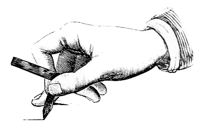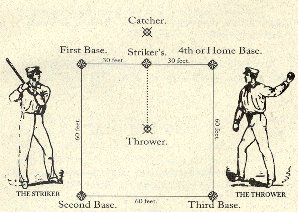Rules of the Massachusetts Association of Base Ball Players
Adopted May 13, 1858 at Dedham, Massachusetts
Property "Version" (as page type) with input value "{{{Version}}}" contains invalid characters or is incomplete and therefore can cause unexpected results during a query or annotation process.
Comments
<comments voting="Plus" />
1. The Ball must weigh not less than two, nor more than two and three-quarters ounces, avoirdupois. It must measure not less than six and a half, nor more than eight and a half inches in circumference, and must be covered with leather.
2. The Bat must be round, and must not exceed two and a half inches in diameter in the thickest part. It must be made of wood, and may be of any length to suit the Striker.
3. Four Bases or Bounds shall constitute a round; the distance from each base shall be sixty feet.
4. The bases shall be wooden stakes, projecting four feet from the ground.
5. The Striker shall stand inside of a space of four feet in diameter, at equal distance between the first and fourth Bases.
6. The Thrower shall stand thirty-five feet from and on a parallel line with the Striker.
7. The Catcher shall not enter within the space occupied by the Striker, and must remain upon his feet in all cases while catching the Ball.
8. The Ball must be thrown - not pitched or tossed - to the Bat, on the side preferred by the Striker, and within reach of his Bat.
9. The ball must be caught flying in all cases.
10. Players must take their knocks in the order in which they are numbered; and after the first inning is played, the turn will commence with the player succeeding the one who lost on the previous inning.
11. The Ball being struck at three times and missed, and caught each time by a player on the opposite side, the Striker shall be considered out. Or, if the Ball be ticked or knocked, and caught on the opposite side, the Striker shall be considered out. But if the ball is not caught after being struck at three times, it shall be considered a knock, and the Striker obliged to run.
12. Should the Striker stand at the Bat without striking at good balls thrown repeatedly at him, for the apparent purpose of delaying the game, or of giving advantage to players, the referees, after warning him, shall call one strike, and if he persists in such action, two and three strikes; when three strikes are called, he shall be subject to the same rules as if he struck at three fair balls.
13. A player, having possession of the first Base, when the Ball is struck by the succeeding player, must vacate the Base, even at the risk of being put out; and when two players get on one Base, either by accident or otherwise, the player who arrived last is entitled to the Base.
14. If a player, while running the Bases, be hit with the Ball thrown by one of the opposite side, before he has touched the home bound, while off a Base, he shall be considered out.
15. A player, after running the four Bases, on making the home bound, shall be entitled to one tally.
16. In playing all match games, when one is out, the side shall be considered out.
17. In playing all match games, one hundred tallies shall constitute the game, the making of which by either Club, that Club shall be judged the winner.
18. Not less than ten nor more than fourteen players from each Club, shall constitute a match in all games.
19. A person engaged on either side, shall not withdraw during the progress of the match, unless he be disabled, or by the consent of the opposite party.
20. The Referees shall be chosen as follows: One from each Club, who shall agree upon a third made from some Club belonging to this Association, if possible. Their decision shall be final, and binding upon both parties.
21. The Tallymen shall be chosen in the same manner as the Referees.

